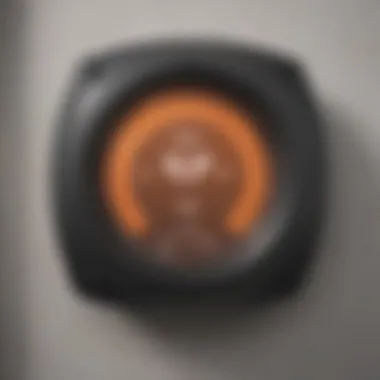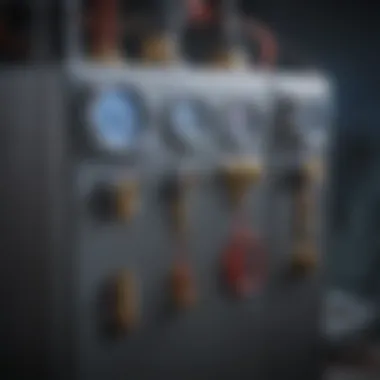Effective Solutions for AC Cold Air Problems


Intro
When it comes to maintaining a comfortable environment in homes and offices, a properly functioning central air conditioning system is crucial. However, many people face issues when their AC fails to deliver the cold air expected, leading to discomfort during hot weather. The ability to troubleshoot these cold air issues effectively is essential for homeowners. Understanding the potential causes behind the lack of cooling is the first step toward addressing the problem.
This article delves into common culprits that result in insufficient cool air, ranging from very basic checks like verifying thermostat settings to examining more complicated factors like refrigerant levels and system malfunctions. By following a systematic troubleshooting approach, individuals can diagnose problems accurately and implement effective solutions, ensuring the indoor climate remains pleasant and conducive to daily activities.
Understanding Central Air Conditioning Systems
Understanding central air conditioning systems is crucial for both homeowners and professionals working with HVAC technology. Awareness of how these systems function allows for better maintenance, minimizes breakdowns, and optimizes energy efficiency. The reliability of indoor climate control strongly depends on the knowledge of core components, operational principles, and the interdependence of each system part.
Familiarity with the central air conditioning framework provides several advantages. It empowers users to deal with minor issues independently, avoiding the unnecessary cost of professional help for simple tasks. It also encourages preventive maintenance, extending the system’s lifespan. Most importantly, comprehending these elements contributes to creating a comfortable home or business environment.
A comprehensive understanding of these systems leads to more informed decisions regarding upgrades or replacements, should they become necessary. Therefore, both the operational theory and the physical components must be examined to provide a complete overview of how central air conditioning systems manage indoor temperatures effectively.
Key Components of Central AC
Central air conditioning systems are made up of several key components, each playing a significant role in the cooling process. The main parts include:
- Compressor: This component circulates refrigerant throughout the system, responsible for converting low-pressure refrigerant gas into high-pressure gas.
- Condenser Coil: Located outside the building, this coil dissipates heat from the refrigerant into the environment, helping it condense into a liquid.
- Evaporator Coil: Found inside the home, it absorbs heat from the indoor air, causing the refrigerant to evaporate into a gas.
- Ductwork: Ducts distribute cooled air throughout the home, enabling efficient airflow.
- Thermostat: This device regulates the indoor temperature by controlling the operation of the entire system.
Understanding how these components work together to manage indoor temperatures is essential for diagnosing issues in central AC systems.
How Central AC Works
Central air conditioning operates based on the principles of thermodynamics, using the refrigerant cycle to absorb and expel heat. The process begins when the thermostat signals the compressor to activate, initiating the flow of refrigerant.
- The compressor pumps refrigerant gas into a high-pressure state, sending it to the condenser coil.
- In the condenser coil, heat is released as the refrigerant changes from a gas back to a liquid state, aided by external air passing over the coils.
- The cooled liquid refrigerant flows to the evaporator coil, where it absorbs heat from the indoor air, cooling it in the process. The refrigerant turns back into a gas.
- The gas returns to the compressor, and the cycle repeats. This continuous loop enables a steady temperature regulation according to the settings of the thermostat.
Understanding this cycle provides essential insight into potential issues that may affect the cooling performance of the system.
Symptoms of Insufficient Cooling
Understanding the symptoms of insufficient cooling in central air conditioning systems is essential for effective troubleshooting. Recognizing these signs early can save homeowners from larger issues down the line. If the AC unit is not operating at optimum levels, it may not only be uncomfortable but can also lead to increased energy bills.
Proper diagnosis of these symptoms allows for targeted interventions. Identifying whether the problem stems from simple user error or complex technical faults can make a significant difference in addressing the cooling issue quickly and efficiently.
Inconsistent Temperature
When an air conditioning system fails to maintain a consistent temperature, it may indicate several underlying problems. Homeowners may notice that some rooms are cooler than others, while others feel uncomfortably warm. This inconsistency often stems from poor airflow, dirty air ducts, or even issues with the thermostat itself.
A malfunctioning thermostat can misread the indoor temperature, causing the system not to operate as needed. Checking and recalibrating the thermostat is a straightforward task that may resolve any inconsistency in temperature. If the problem persists after this adjustment, it could be a sign of deeper issues like duct leaks or insufficient refrigerant flow.
Warm Air Discharge


The unexpected discharge of warm air from vents is one of the most obvious signs of an AC problem. This can be alarming, especially on hot days when cool air is desperately needed. Warm air discharge can occur due to multiple factors.
One common reason is a problem with the refrigerant. Low refrigerant levels can lead to a failure in the cooling cycle, causing warm air to flow through the vents. Checking the refrigerant level should be a priority, as handling refrigerants requires professional knowledge and tools.
In addition, a malfunctioning compressor can also lead to warm air being emitted. The condenser coils must also be clean and free of blockages; otherwise, the system cannot expel heat properly.
Unusual Noises
Unusual noises from an air conditioning system can indicate various problems. Homeowners should pay attention to sounds that seem out of the ordinary. For example, if there is a rattling sound, it could suggest that parts have become loose or that debris is obstructing the unit. Alternatively, a high-pitched squealing noise may indicate a failing motor or a problem with the fan.
Ignoring such noises can lead to costly repairs if the issue worsens. Regular monitoring for these unusual sounds can alert homeowners to potential malfunctions early on, allowing for timely action before further damage occurs.
Important Note: Always ensure proper maintenance and regular inspections of the AC unit to mitigate future problems related to inadequate cooling.
Common Causes of AC Not Blowing Cold Air
Understanding the common causes of an air conditioning system failing to blow cold air is essential for diagnosing and rectifying issues swiftly. By identifying these causes, homeowners can minimize discomfort, save on energy costs, and prolong the lifespan of their AC units. Neglecting this aspect can lead to more significant problems over time. This section breaks down these causes, facilitating better decision-making.
Thermostat Settings
Thermostat settings play a crucial role in the proper functioning of an air conditioning unit. Many issues arise simply from incorrect settings. Homeowners should regularly check to see if the thermostat is set to cooling mode. In some cases, the settings may be accidentally altered, leading to warm air circulation. Other aspects include checking the thermostat's location; if it is incorrectly placed in direct sunlight or near heat sources, it gives false readings, causing improper operation. In summary, ensuring the thermostat is set correctly is an easy yet vital first step in troubleshooting.
Clogged Air Filters
Air filters are essential for effective airflow within an air conditioning system. When these filters become clogged, air cannot circulate properly, causing the unit to work harder and, eventually, leading to insufficient cooling. Homeowners should check and replace air filters regularly, ideally every one to three months. Clogged filters can not only reduce air quality but also increase energy consumption, making maintenance of air filters both a practical and beneficial habit.
Refrigerant Issues
Refrigerant issues often signify deeper mechanical problems, and understanding these can aid in the troubleshooting process.
Low refrigerant levels
Low refrigerant levels can emerge due to various reasons like leaks or insufficient recharge during installation. This reduces the system’s ability to absorb heat efficiently, leading to poor cooling performance. When the refrigerant level is below the required amount, it can directly impact the system's cooling capacity. This aspect is essential to consider as it often leads to more extensive and costly repairs if not addressed in time. Regular checks can help in monitoring these levels.
Refrigerant leaks
Refrigerant leaks significantly affect the overall efficiency of an air conditioning unit. These leaks can develop in various locations, and their presence can be challenging to detect. A system that is low on refrigerant will struggle to maintain the desired temperature, and continuous operation under these conditions can damage the compressor. It is critical to find and seal leaks promptly before significant damage occurs. Homeowners must be vigilant for signs of leakage, such as icy formations around coils or higher-than-normal energy bills.
Refrigerant overcharge
Refrigerant overcharge happens when too much refrigerant is added to the system. This can lead to high pressure within the system, which may cause poor performance or even operational failure. Symptoms of overcharge can include abnormal noises or a system that cycles on and off frequently. Though this may not seem as prevalent as low refrigerant levels or leaks, it is a noteworthy concern that can lead to reduced efficiency and increased repair needs. Awareness of correct refrigerant levels is vital for maintaining system health.
Faulty Condenser Coils


Condenser coils release heat from the refrigerant. If these coils become dirty or damaged, they struggle to remove heat effectively, leading to a drop in cooling performance. Regular cleaning and inspection can help avoid issues related to condenser coils. Homeowners should ensure that they are free from dirt, leaves, and other potential blockages to maintain proper airflow and system efficiency.
Blocked Ductwork
Ductwork carries the cooled air throughout the home. When ducts become blocked, it can severely restrict airflow, resulting in uneven cooling or no cool air at all. This can result from dust build-up, debris, or even structural issues within the ductwork itself. Evaluation and cleaning of duct systems can help maintain optimal airflow. Regular inspections are warranted to detect and resolve any blockages.
Maintaining awareness of these common causes allows homeowners to take proactive steps in ensuring their air conditioning systems operate effectively.
Maintenance Considerations
Maintenance of central air conditioning systems is crucial. It plays a key role in ensuring that the system functions optimally, preventing breakdowns and inefficiencies. Homeowners often overlook this aspect, assuming that once the system is installed, it will work without any need for attention. This assumption can lead to increased energy costs and uncomfortable indoor environments.
Proper maintenance encompasses several elements. These include regular filter replacement, annual system checkups, and seasonal preparations. Each of these elements offers distinct benefits and contributes to the overall efficiency of the AC unit. By understanding these components, homeowners can take proactive steps to maintain their systems, thereby avoiding costly repairs in future and extending the unit's lifespan.
Regular Filter Replacement
Air filters are a small yet essential part of central AC systems. They trap dust, pollen, and other particulates, ensuring that clean air circulates throughout the home. Over time, filters become clogged, significantly reducing airflow and efficiency.
Key points about filter replacement:
- Frequency: Filters should be checked every month and replaced at least every three months. Some systems may require more frequent changes.
- Impact on Performance: Dirty filters can cause the system to work harder, leading to higher energy bills and potential damage to the AC unit.
- Health Benefits: Clean filters improve indoor air quality, making the environment healthier for residents.
Neglecting to change filters can result in increased wear and tear on the system, leading to early failure or the need for extensive repairs.
Annual System Checkups
Annual checkups should be viewed as a necessity rather than an option. These checkups help identify potential issues before they escalate into serious problems.
Advantages of regular checkups include:
- Expert Diagnosis: A qualified technician can inspect all components of the system, ensuring every part is functioning as intended.
- Preventative Repairs: Addressing small issues early on can prevent them from developing into more significant and costly repairs.
- Efficiency Optimization: Over time, systems lose efficiency. Annual checkups allow for recalibration and servicing of key components, improving overall performance.
Consider scheduling these checkups at the beginning of the cooling season to ensure the system is ready for use.
Seasonal Preparations
Preparing the AC system for seasonal changes is essential for optimal performance. As summer approaches, it’s important to ensure that the system is ready to deliver cold air.
Seasonal preparations should include:
- Cleaning Outdoor Units: Remove debris, leaves, and dirt from outside units to ensure proper airflow.
- Checking Insulation: Inspect ductwork for gaps, which can lead to cold air escaping.
- Testing the System: Run the AC for a short period to verify it starts and cools properly.
Taking these steps as seasons change can greatly enhance system reliability and performance. It can also save money in repair costs and enhance comfort in the home.


"Routine maintenance can extend the life of your central air conditioning system significantly."
By emphasizing regular filter replacement, annual checkups, and seasonal preparations, homeowners can maintain their systems effectively, ensuring they remain cool and efficient throughout the hottest months.
When to Call a Professional
Knowing when to seek professional help with your central air conditioning system is essential. Many homeowners initially try to handle issues independently, believing they can fix minor problems without expert assistance. However, some situations require the skills and knowledge of trained professionals.
It is important to recognize that calling a professional can save time and potentially prevent further damage to the system. A trained technician can diagnose problems effectively, ensuring repairs are done correctly and efficiently. The following are key signs that indicate it might be time to contact a pro.
Signs of Major Malfunctions
Several symptoms may signify deep-rooted issues in your AC system. Awareness of these signs can help prevent escalation and reduce repair costs:
- Inability to cool: If your AC is not cooling at all despite setting the thermostat appropriately.
- Frequent cycling: The unit turns on and off repeatedly, indicating a potential problem with the thermostat or compressor.
- Visible leaks: Puddles of water or refrigerant below your AC system can signal leaks.
- Electrical issues: Tripped circuit breakers or burning smells can mean serious electrical faults.
If you observe any of these signs, it’s advisable to call a professional to assess the issue.
Cost-Effective Repair Considerations
Calling a professional doesn’t mean you have to spend excessively. Here are some considerations that may assist you in making cost-effective repair decisions:
- Obtain multiple estimates: Obtaining quotes from various companies can help ensure you get a fair price for necessary repairs.
- Consider long-term savings: Sometimes, spending a bit more on high-quality repairs can lead to better energy efficiency in the long term, saving you money on utility bills.
- Look for warranties: Many technicians offer warranties on parts and labor. This can provide peace of mind and prevent additional costs in the future.
- Regular maintenance discounts: Some services offer discounts to customers who schedule regular checkups. Being proactive may enhance your AC’s lifespan.
Remember, attempting repairs without understanding the issue can lead to greater problems. It’s better to consult a professional to resolve these issues efficiently.
Preventive Measures for Future Issues
Taking proactive steps to prevent cold air issues in central air conditioning systems is essential for both comfort and peace of mind. Homeowners often face inconvenient breakdowns and inconsistent temperatures if they neglect certain preventive measures. The following sections detail specific elements such as system upgrades and efficiency improvements, along with smart home integration.
System Upgrades and Efficiency
Upgrading central air conditioning systems may seem like a significant investment, but it can lead to long-term advantages. Older models often consume more energy and may fail to provide adequate cooling. Investing in energy-efficient models can result in lower utility bills and less environmental impact.
Here are some key considerations for system upgrades:
- SEER Rating: When evaluating new air conditioning units, pay attention to the Seasonal Energy Efficiency Ratio (SEER). Higher SEER ratings indicate better efficiency, which can save money in the long run.
- Variable-Speed Compressors: These allow the system to adjust its cooling output based on demand. They operate more efficiently and enhance comfort by maintaining consistent temperatures.
- Proper Sizing: Ensure the new system is appropriately sized for your space. An oversized unit cools too quickly without properly dehumidifying the air. Conversely, a unit that is too small cannot effectively cool the area.
- Insulation and Sealing: Along with system upgrades, check your home’s insulation and sealing. Better insulation reduces energy loss, improving the efficiency of your AC system.
Smart Home Integration
Incorporating smart home technology into your central air conditioning can further streamline operations and enhance efficiency. Smart thermostats, for instance, provide greater control over your temperature settings. These devices learn your habits and adjust the climate accordingly, which can lead to substantial energy savings.
Here are benefits you can expect from smart home integration:
- Remote Control: Adjust your thermostat via smartphone apps, allowing you to set the temperature before arriving home.
- Energy Usage Reports: Many smart thermostats offer insightful data on how much energy you are using, enabling informed decisions for reducing consumption.
- Integration with Home Automation Systems: Smart thermostats can work with other home systems, making it easier to maintain comfortable conditions. This includes scheduling adjustments based on your needs or integrating with climate sensors throughout your home.
"Preventive measures can save you both time and money, ensuring a comfortable living environment year-around."
By implementing these preventive strategies, you can minimize the risk of future cooling problems. Regular upgrades, coupled with smart home technologies, not only enhance your AC system’s performance but also allow for a more responsive and comfortable living situation.















